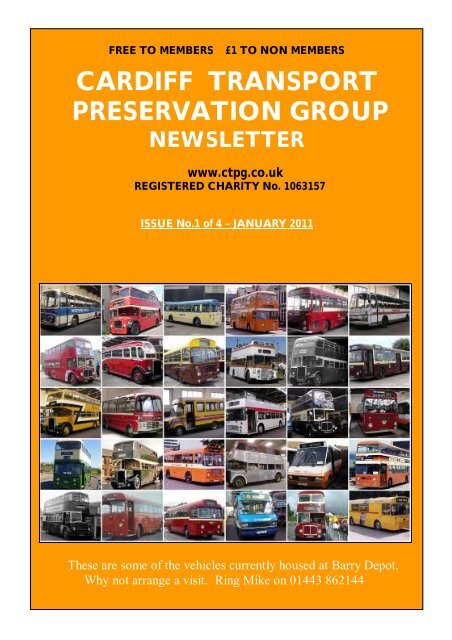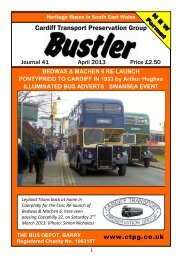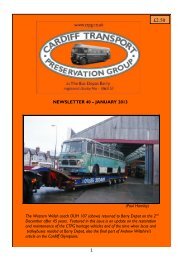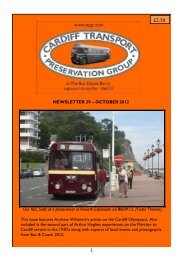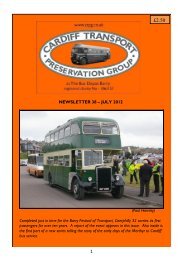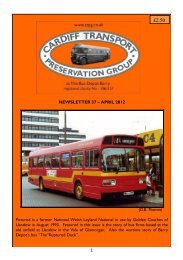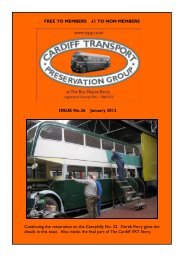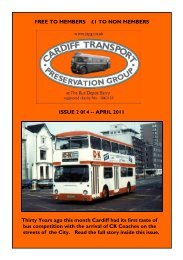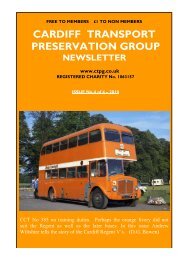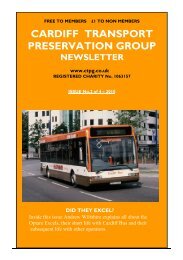Create successful ePaper yourself
Turn your PDF publications into a flip-book with our unique Google optimized e-Paper software.
FREE TO MEMBERS<br />
£1 TO NON MEMBERS<br />
CARDIFF TRANSPORT<br />
PRESERVATION GROUP<br />
NEWSLETTER<br />
www.ctpg.co.uk<br />
REGISTERED CHARITY No. 1063157<br />
ISSUE No.1 <strong>of</strong> 4 <strong>–</strong> JANUARY <strong>2011</strong><br />
These are some <strong>of</strong> the vehicles currently housed at Barry Depot.<br />
Why not arrange a visit. Ring Mike on 01443 862144<br />
1
GLAMOUR COMES TO BARRY DEPOT<br />
Above is a fashion shoot for the “Buzz” magazine. The models were Cathy Corry and<br />
Jennifer Morgan. The wedding scene below was to promote a new bridal shop at Cardiff.<br />
Photos; Aga Tomaszek and Paul Hamley.<br />
2
CHAIRMAN’S MESSAGE;<br />
A Happy New Year to you all and welcome to the first newsletter <strong>of</strong><br />
<strong>2011</strong>. As mentioned last month, newsletters will now be issued in<br />
January, April, July and October, so that our rally reports are current<br />
rather than appearing months after the event.<br />
The weather has prevented much going on at Barry during December.<br />
I think there was more snow than they have seen in many years.<br />
However, the KMB Regent made it from Oxford, between the<br />
snowstorms, and what a monster it is. Hopefully it will be available for our<br />
rally and a road run this year.<br />
Unfortunately the frost has damaged the internal paint work <strong>of</strong> the depot<br />
again, more than last year in fact, so spring will mean a bit <strong>of</strong> tidying up is<br />
required. Any Volunteers?<br />
Pontypridd No.8 and the R&W Tiger are pretty much ready for MOT’s<br />
and Caerphilly 32 has started to be prepared for painting, both inside and<br />
out. Hopefully we can then get the cylinder head <strong>of</strong>f the Jones Cub again<br />
to see what is going on, it has a history <strong>of</strong> head gasket problems<br />
stretching back many years. Cardiff 497 is still under preparation for<br />
painting, more help would be appreciated.<br />
I have plans to improve the outside <strong>of</strong> the Depot building this year, with<br />
some new signage to show what the building is used for. Also I want to<br />
see what’s left <strong>of</strong> the original signage, hidden behind the current cladding.<br />
For those <strong>of</strong> you that enjoy your internet, we have a Facebook page. I try<br />
to keep this up to date with photos <strong>of</strong> the happenings at Barry. The site is<br />
open to all to have a look and add your own photos. We have over 110<br />
friends at the moment.<br />
<strong>2011</strong> Agenda;<br />
19 th January; AGM<br />
16 th February; Cine Film Evening<br />
16 th March; Peter Heath’s “An A to Z <strong>of</strong> buses and a few coaches”<br />
20 th April; To be announced<br />
Mike. Tel: 07796 265229<br />
Email : mikeystrad73@btinternet.com<br />
3
DEREK’S LOG; by Derek Perry;<br />
UTG 313G AEC Regent V<br />
The rear O/S flat panel had been marked and a hole cut to take the new<br />
number plate panel, both rear panels were then fitted. Two wooden<br />
wedges and some aluminium packing pieces had to be fitted to get the<br />
outside bodylines correct. The number plate and lamp have been fitted.<br />
The window surround pieces were in the box <strong>of</strong> bits, and have now been<br />
sorted and fitted. The N/S curved corner panel had to be trimmed at the<br />
bottom before fitting, but is now in place. The two N/S side panels that<br />
fit to the corner panel had to be removed, adjusted and fitted with<br />
packing, again to align the outer bodylines.<br />
Some <strong>of</strong> the side window surround pieces are missing so new ones have<br />
been cut and fitted. With the back end in place the O/S corner panel was<br />
measured and cut to take the two lamps, the wiring that Graig fitted was<br />
then connected to all rear lamps. The body trim strips have also been<br />
refitted or replaced.<br />
4
The N/S corner has had the higher panel removed as the top corner<br />
timber was damaged. It was cleaned up and repaired, so the panel has<br />
now been refitted complete with its trim strips. The job is at last starting<br />
to look good.<br />
Craig and Mike have been rebuilding the rear seat supports, refitting the<br />
seat frame, and rubber matting to the floor. The rear seat supports have<br />
been cleaned, undercoated, and finished <strong>of</strong>f using the outer blue. The seat<br />
pads on the lower level have been removed and the frames painted black,<br />
by Viv Corbin,<br />
A decision was made on how many panels were to be painted; filling and<br />
rubbing down then took place. The cream top panels have been painted<br />
with two coats <strong>of</strong> enamel and look very good. The blue paint which came<br />
with the vehicle is cellulose based and has not taken to being brushed on;<br />
we also find that it is not drying. We have since found out that the paint<br />
is what is called “two-pack” and has to have a hardener mixed with it<br />
before spraying on. As it has not hardened we have been able to wash it<br />
<strong>of</strong>f with thinners but some areas had to have paint remover and were<br />
cleaned all back to bare metal. The area was undercoated and a tin <strong>of</strong><br />
enamel obtained and three coats applied. The rear lights were fitted,<br />
together with the number plate. Apart from the hinge bolts the outside,<br />
the rear is finished. Oops! I take that back, it seems the earth connection<br />
<strong>of</strong> the number plate lamp is not up to the regulations, so insulated bulb<br />
holders have been fitted and a cover plate made and fitted.<br />
The floor has been patched upstairs and down, an inspection panel in the<br />
floor was lying a little low and had to be packed up to the same level as<br />
the rest <strong>of</strong> the floor. Paul Gilbertson and Richard Evans have been<br />
cleaning out the inside and painting the upstairs and downstairs floors and<br />
Viv Corbin has painted the upstairs seat frames.<br />
Richard Fitzjohn and myself rubbed down and painted the inside blue<br />
panelling (there is a lot <strong>of</strong> it). The seat pads have been sorted, using some<br />
stock from the store room, and fitted into place. Peter Smith washed<br />
them and applied a leather balm to s<strong>of</strong>ten and shine them.<br />
5
GNY 432C Leyland Titan<br />
When assembling the rear emergency door, a little trimming <strong>of</strong> the<br />
aluminium strip we had fitted around the frame was necessary. The outer<br />
skin then fitted into place using longer screws in the original holes.<br />
Crimping the edge <strong>of</strong> the skin onto the edge trim made the whole job<br />
solid. With the Formica cleaned up and glued back into place with the<br />
locking bar and handles refitted, the door was ready for refitting.<br />
With the help <strong>of</strong> a third pair <strong>of</strong> hands, (Namely Mike) longer screws have<br />
held the three hinges back in place.<br />
A trim strip fitted around the door on the body also holds a rubber seal<br />
for the door to fit against, needless to say the rubber has had to be<br />
replaced. Rubber matting was cut to size and the trim screwed back onto<br />
the body. The door closes and locks; another job completed.<br />
The lower emergency door on the side <strong>of</strong> the vehicle was seized shut; the<br />
handle was the first thing to free <strong>of</strong>f, followed by the piano hinge at the<br />
top <strong>of</strong> the door. We then found that the hinge fitted flat on the outside<br />
6
<strong>of</strong> the body, riveted to the door and held onto the body by screws<br />
through the half round trim strip. Half <strong>of</strong> these screws were not holding,<br />
but after replacing them with new screws, the hinge held firm on both<br />
sides allowing the door to be worked back and forth until free.<br />
The six air vents on the ro<strong>of</strong> have been flattened by passing trees and<br />
suchlike and were accessible only by the scaffolding tower. Peter Smith<br />
bravely took to these heights in an attempt to remove them. They are<br />
made up <strong>of</strong> a base plate with three separate shaped covers with gaps<br />
provided to let in the air; these are then bolted onto the ro<strong>of</strong> with round<br />
headed bolts that would not shift. Peter has spent time in straightening<br />
them in place as best he can but it was decided to remove them. The<br />
front sections, having had the most damage, resisted normal removal so<br />
the angle grinder was used to remove the bolt heads and the panel. On<br />
the bench panel beating has made it reusable, and it has been pop riveted<br />
and sealed back in place. Five more to go!<br />
In the attempt to<br />
remove the outer<br />
vents, an inner vent<br />
cover (pictured)<br />
was removed to<br />
access the inner<br />
nuts. On removal<br />
these vent covers,<br />
which are made <strong>of</strong><br />
copper, appear to<br />
be covered in a<br />
thick layer <strong>of</strong> plastic<br />
material that is no<br />
longer adhering to<br />
the surface; we have decided to take them all <strong>of</strong>f, to strip and paint.<br />
Richard Evans spent a day removing all traces <strong>of</strong> the coating and they are<br />
now ready for painting.<br />
Rubbing down further sections <strong>of</strong> bodywork is now going ahead; small<br />
indentations are being filled and smoothed. With the improved facilities<br />
we now have, we have looked more critically at three panels to the front<br />
7
<strong>of</strong> the N/S rear wheel. Corrosion has taken place and the decision has<br />
been taken to remove and replace them. The side trim just to the rear <strong>of</strong><br />
the front N/S wing has loose screws. We have now obtained longer<br />
screws and the fitting <strong>of</strong> these have rectified the problem.<br />
Peter Smith has had a look at the front folding doors. The left hand<br />
rubber seal disintegrated long ago and a repair on it has also collapsed.<br />
All the remains have now been removed and a new rubber fitted into<br />
place. The loose cross trimmings at the bottom <strong>of</strong> the doors have now<br />
been re-screwed, and rubbing down is taking place. When the doors are<br />
closed the top fits fine, but the bottom overlaps. The rear bottom hinge<br />
swivel is a round bar which is badly worn and rusted with the surrounding<br />
support brackets practically non-existent.<br />
The area has been cleaned up, a new support made and welded into place<br />
and painted with red lead. A panel has been made and fitted to the body<br />
below the folding doors. Panels have also been made and fitted to the rear<br />
N/S corner, inside and out, and trims fitted over the joins.<br />
The rear emergency door has also received our attention; the outer edge<br />
<strong>of</strong> the wood frame has rotted. Attempts to remove the door failed, so<br />
the trim strips have been removed and the lower part <strong>of</strong> the outer skin<br />
has been taken <strong>of</strong>f and a repair to the wood frame has taken place. We<br />
used a metal plate along the bottom for the skin to fold over, the skin has<br />
now been checked over, cleaned up, and refitted.<br />
Now that the rear and door panels are fitted, the hinge pillar is seen to be<br />
in too far at the centre hinge and is pulling the door out <strong>of</strong> line with the<br />
body; some adjustment has had to take place.<br />
(what chassis is this?)<br />
8
DWO 123<br />
AUTONUMEROLOGY;<br />
This was the term used to describe the hobby <strong>of</strong> noting vehicle number<br />
plates, whereas nowadays youngsters would probably just use the three<br />
letter word <strong>–</strong> ‘Sad.’ However as bus enthusiasts, it was and still is,<br />
common for us to use motor tax records in our hobby.<br />
In the late 1940s a brown covered booklet was published called ‘Where’s<br />
That Car From?’ which listed all the registration letters issued by the<br />
various County Councils and County Burghs. A year or two later the<br />
Measham Motor Auctions produced a little green booklet giving the dates<br />
<strong>of</strong> when the various registration letters were issued, which was <strong>of</strong> great<br />
help to the enthusiast. I still have my copy. (How sad is that?)<br />
Much <strong>of</strong> the detail from these books was committed to memory, but now<br />
60 years on most <strong>of</strong> this has gone (How sad again). Carved in stone<br />
though are the registration marks used in the south east <strong>of</strong> Wales, i.e.<br />
Glamorgan’s NY,TG, TX; Cardiff’s BO, KG, UH; Monmouth’s AX & WO<br />
along with DW and HB from Newport and Merthyr Tydfil. These were<br />
normally issued alphabetically in their own areas; but with some<br />
exceptions. These were also the most numerous to be seen on the buses<br />
and coaches I used to see travelling to Barry Island in the late 1940s.<br />
When three letter registration marks began to appear, (Staffordshire was<br />
the first in July 1932 with ARF 1) it was decided that certain letter<br />
combinations would be omitted where they may cause <strong>of</strong>fence, e.g. BUM,<br />
GOD, JEW and SEX etc.<br />
However, in 1958 it was considered fine to issue PAK in Bradford, but I<br />
doubt if that would be the case these days. A few years later Essex C.C.<br />
issued LOO and POO (in numbers first format).<br />
Strangely, Monmouthshire’s DWO mark was not issued. Does anyone<br />
know why? It was thought perhaps there was an irreverent meaning in<br />
the Welsh language, but this drew a blank. There are very few words in<br />
the English language begin with DW; and anyway Newport C.B.C. didn’t<br />
have a problem issuing DW marks.<br />
9
In Sept. 1939 when DAX 999 was reached, Monmouthshire Council saw<br />
fit to leave out DWO and jump straight to EAX 1. Similarly in May 1962<br />
when the reversed 999 DAX was issued it was followed by 1 EAX.<br />
Even with the year suffix plates (issued locally as ‘B’ from Feb. 1964) poor<br />
old DWO was again omitted.<br />
In 1974, local authorities that issued vehicle registrations were replaced<br />
by Local Vehicle Licensing Offices (LVLO’s). Initially, there were 81<br />
LVLO’s but these have since been reduced to 39, and now called DVLA<br />
Local Offices. The former Glamorgan, Cardiff, Monmouth, Newport and<br />
Merthyr index marks were then issued from a new <strong>of</strong>fice at Cardiff.<br />
Following the introduction <strong>of</strong> prefix registrations in August 1983, again<br />
DWO escaped. Then suddenly, I think was about 1997, Voila! DWO<br />
was issued at last (I think with an ‘R’ prefix). This prompted me to write<br />
to the Cardiff VRO at the time to ask why this particular combination <strong>of</strong><br />
letters had not been used before. They replied that they were aware that<br />
DWO had not been used before, but had no idea why. So does anyone<br />
know why? Or who cares? Of course the three letter combinations<br />
issued from Sept 2001 are random and have no significance. Another<br />
facet <strong>of</strong> motoring history had disappeared. (V. C.)<br />
----------------------------------------<br />
DECEMBER MEETING;<br />
Our annual quiz night, once again hosted by Chris Taylor, was enjoyable<br />
and well attended. The room was split into four teams, which included<br />
two guests from Somerset. Obviously most <strong>of</strong> the questions were about<br />
buses, their operators and manufacturers, but a variety <strong>of</strong> transport<br />
related subjects were touched upon. For instance, did you know that the<br />
Chinook helicopter was named after a wind that crosses the Canadian<br />
Prairies? There was no cheating <strong>of</strong> course, just a bit <strong>of</strong> gentle earwigging.<br />
During the break, mince pies and sausage rolls were handed<br />
around <strong>–</strong> lovely! Chris was assisted by Nicky Reason who asked us to<br />
identify pictures <strong>of</strong> old road traffic signs. Well, some <strong>of</strong> us don’t even<br />
understand the current signs! Modesty prevents me from naming the<br />
leader <strong>of</strong> the winning team, but I’m sure they will be out to get me at the<br />
next quiz night.<br />
------------------------------------------<br />
10
Oxford Bus Museum Mini-Running Day, 21st March 2010<br />
by Berwyn Prys Jones<br />
Colourful full-page adverts in the March edition <strong>of</strong> Buses magazine and the<br />
April edition <strong>of</strong> Bus and Coach Preservation highlighted several attractions<br />
<strong>of</strong> the Oxford Bus Museum’s March mini-running day: the unusual if not<br />
unique City <strong>of</strong> Oxford livery on two AEC Regents and the launch <strong>of</strong> two<br />
books including one in Presbus’s ‘Return Journey’ series on the City <strong>of</strong><br />
Oxford fleet itself. A visit to the museum at Long Hanborough some<br />
years ago had made me promise to myself that I’d return for a running day<br />
at some point and this seemed as good a time as any. An early start from<br />
Cardiff should have made it an easy journey but finding Long Hanborough<br />
wasn’t as simple at it looked on the map.<br />
Arrival at Long Hanborough was a little later than the <strong>of</strong>ficial ten o’clock<br />
start, but I needn’t have worried. Though a small group <strong>of</strong> people had<br />
already parked their cars in the car park the gates weren’t yet open. The<br />
advert had said 10.00am but no-one inside the museum yard seemed keen<br />
to open the gates and the stallholders were still unloading their<br />
merchandise. It was 10.30 by the time the gates opened and a small<br />
crowd <strong>of</strong> us swarmed into the museum shop to pay our entrance fees.<br />
Any delay was swiftly forgotten for in the yard stood the magnificent<br />
lowbridge Weymann-bodied AEC Regent III PWL 413 with its livery<br />
sparkling. It was something <strong>of</strong> a disappointment, though, to find out that<br />
it wouldn’t be loading up and leaving straight away: there’d be an hour’s<br />
wait before departure. An hour, though, provided plenty <strong>of</strong> opportunity<br />
to photograph PWL and the other buses on show before too many other<br />
people arrived and made photography difficult.<br />
In the first shed on the left were the East Lancs-bodied Dennis Loline 304<br />
KFC and exposed-radiator AEC Regent V 956 AJO along with 14 LFC, the<br />
Wadham-bodied one-and-a-half decker coach <strong>of</strong> the Morris Motors Band,<br />
which by comparison with the ex-City <strong>of</strong> Oxford buses was in a rather<br />
drab livery <strong>of</strong> dark blue and cream. Still it reminded visitors that the bus<br />
museum site also houses a small but intriguing Morris motor museum<br />
filled with all kinds <strong>of</strong> Morris memorabilia, including a bull-nosed Morris<br />
11
and a Morris Minor police panda car <strong>of</strong> a design that always seemed to me<br />
to be too rickety to uphold the full majesty <strong>of</strong> the law.<br />
The Morris Motors Band coach must have given players an exalted view <strong>of</strong> their<br />
performance.<br />
In a further shed stood a few more AECs, the most striking one with<br />
Metal Sections bodywork and an ABW 225D registration plate displaying<br />
‘Kowloon City Ferry’ on its destination indicator. That and its slightly<br />
awkward-looking bulk proclaimed it had spent some years away on distant<br />
shores. Beside it stood AEC Reliance bus 756 KFC, <strong>of</strong> which more later.<br />
Tucked away at the back was OFC 393 another AEC Regent III, this time<br />
with a highbridge Weymann body. It was, though, in a plain dull red. Was<br />
that the livery <strong>of</strong> a subsequent owner? Chris Butterfield <strong>of</strong> the Museum<br />
explains, “Each December (see our website diary for details) we have<br />
Santa days when children visit Santa in his grotto. For the last two years,<br />
we have used this bus, but it was thought it would look more festive<br />
painted red.” In front <strong>of</strong> it stood a dilapidated (or should I say ‘unrestored’)<br />
Morris 8 Series E which brought back memories <strong>of</strong> the one my<br />
12
parents owned many years ago and featuring, even then, a sunshine ro<strong>of</strong>.<br />
I can just about remembering standing on the a seat with my head out in<br />
the fresh air ...<br />
In a shed at the far end <strong>of</strong> the site was the Willowbrook-bodied DP32F<br />
AEC Regal III NJO 703. Unfortunately it was being worked on and looked<br />
unlikely to be running at all that day.<br />
Parked alongside the museum building was the Northern Counties-bodied<br />
AEC Renown FWL371E with its rear emergency door open. Behind it,<br />
slightly incongruously, stood a Citaro, bringing a taste <strong>of</strong> modernity to the<br />
whole show. What made me laugh was the large photo on its rear <strong>of</strong> a<br />
young couple kissing rather passionately. Well, I suppose sex will sell<br />
almost anything, but give me City <strong>of</strong> Oxford’s old livery any time!<br />
The museum building itself, funded by a handsome lottery grant, has<br />
plenty to fascinate even those least interested in buses. Apart from the<br />
vehicle there are plenty <strong>of</strong> old photographs and examples <strong>of</strong> old signs and<br />
so on <strong>–</strong> a really good collection <strong>of</strong> memorabilia. Human interest is added<br />
by having models <strong>of</strong> people placed here and there, including inside some<br />
<strong>of</strong> the buses themselves. I stepped into an OB, JVF 528 ex Bensley <strong>of</strong><br />
Martham, and was startled to find I wasn’t on my own as I’d supposed.<br />
There was a very life-like ‘driver’ at the wheel.<br />
At the entrance to the building, incidentally, there’s an unusual exhibit, an<br />
ex-City <strong>of</strong> Oxford Duple-bodied AEC Regal III OFC 205, pretty much as if<br />
it had been left on a farmyard and allowed to deteriorate slowly in the<br />
wind and the rain. Just inside the open door stands a hen (a plastic one,<br />
naturally) but every now and then a recorded squawk gives some added<br />
atmosphere (and frightens and delights the visiting kids) ...<br />
As I stood there waiting to photograph the coach, a mother was busily<br />
explaining the exhibit to her young daughter and it was great just to listen<br />
to her, as a non-enthusiast, describing how people used to travel and<br />
what kind <strong>of</strong> buses they used. The museum was obviously justifying its<br />
existence and its heritage lottery grant.<br />
Other interesting exhibits included JO 5403, a Brush-bodied open-top<br />
AEC Regent 661 looking old but dignified and the chassis <strong>of</strong> JO 5032, an<br />
AEC Regal 642 with ‘Regal 4’ (not ‘IV’) on its radiator.<br />
13
(PSV Circle records show JO5032 was new as Oxford 41 in 1932, fitted with<br />
the A139 AEC 5.1 litre four cylinder petrol engine and a Weymann 32 seat<br />
body. The Regal 4 was introduced to compete against the Leyland Lion, but had<br />
little success as only 177 were built. Ed.)<br />
A venerable ‘Joe’ without the lid on.<br />
Also on show were SFC 610, a Willowbrook-bodied centre-entrance<br />
AEC Regal IV coach and TWL 928, a Park Royal-bodied AEC Regent III.<br />
The latter had been used in the advertisement for the mini-running day<br />
but sadly wasn’t in use today. There too was the Denis Loline I/East Lancs<br />
305 KFC with its side panels removed and the bonnet left open so that<br />
visitors could see for themselves the various parts <strong>of</strong> a working bus.<br />
Harking even further back are several buses in various states <strong>of</strong> undress,<br />
as it were, mainly early Daimlers with their chassis and wooden frames<br />
clearly visible. The museum certainly packs in a lot in a comparatively<br />
small space and is worth visiting several times to really appreciate all it has<br />
to <strong>of</strong>fer. As it was coming up to 11.30, the first trip <strong>of</strong> the day was due to<br />
14
depart and PWL stood invitingly in the yard. Too invitingly perhaps, for<br />
when I clambered up the stairs eager to sample the somewhat mixed<br />
delights <strong>of</strong> travelling on a lowbridge I found it had already attracted far<br />
too many people. A quick retreat to the downstairs saloon was called for.<br />
Off we eventually went, out <strong>of</strong> the museum yard into the Hanborough<br />
station yard and along the narrow road to reach the main highway to<br />
Oxford. It was to be a very pleasant round trip <strong>of</strong> some five or six miles<br />
including a fairly twisty stretch through a small village, a mile or so out<br />
into the countryside, and then about a mile along a dual carriageway past<br />
an airfield and on to a small estate <strong>of</strong> <strong>of</strong>fices and car showrooms.<br />
The driver pulled up at a bus stop on the estate and the conductor who’d<br />
issued us with proper-looking Oxford Bus Museum tickets announced a<br />
photo-stop. Gentlemen with cameras duly got <strong>of</strong>f and photographed PWL<br />
to their heart’s content.<br />
One enterprising gentleman had solved the conundrum <strong>of</strong> how to<br />
combine filming the bus with travelling on it at (almost) the same time. He<br />
had a quiet word with driver, proceeded down the road to a nearby<br />
roundabout and filmed the bus going past. Just down the road the bus<br />
driver pulled up while the gentleman with the video camera ran after the<br />
bus and jumped back aboard. A good enough idea for me to follow his<br />
example on the second trip ... We made our way back to the museum,<br />
most <strong>of</strong> us (enthusiasts anyway) thinking we could enjoy a much longer<br />
trip on this bus.<br />
Back at the museum it was time to visit the stalls and relieve them <strong>of</strong> the<br />
City <strong>of</strong> Oxford book and a DVD <strong>of</strong> the Lathalmond Running Days (though<br />
unfortunately <strong>–</strong> but perhaps fortunately for viewers - not <strong>of</strong> the one that<br />
Mac Winfield and I visited last May).<br />
By this time, the exposed-radiator AEC Regent V, 956 AJO, had been<br />
brought out. Its highbridge Park Royal body suggested that despite being<br />
seven years younger, it might well belong to the same batch as PWL 413.<br />
On the road, though, it was another matter. With a lighter body and<br />
despite having a smaller engine, it was a very different creature and<br />
appreciably quicker. We followed the same route as before with the<br />
same photo-stop.<br />
I walked back to the car to find, as I did at Lathalmond, cause to ask<br />
“Haven’t I seen you somewhere before?’” this time to Ge<strong>of</strong>f Phillips <strong>of</strong><br />
Neath, another CTPG and PSV Circle member. He had, as it happened,<br />
15
parked his car right next to mine. We had a chat and he pointed out the<br />
similarities between the vehicles bought by City <strong>of</strong> Oxford and South<br />
Wales Transport. We wondered what had happened to the ex-James <strong>of</strong><br />
Ammanford Atlanteans that had migrated to City <strong>of</strong> Oxford and lasted<br />
there for quite a while. Did any still exist?<br />
We then went our separate ways until we met again on the Regent V’s<br />
second trip. By then, the AEC Reliance had been added to the two<br />
Regents as running vehicles, so at the photo-stop we swapped the Regent<br />
for the single-decker for the return journey.<br />
AEC come ….. AEC go ….<br />
Filming the Regent V’s last departure brought a very enjoyable and<br />
memorable day to an end. The weather had been mostly sunny, if a little<br />
chilly, and as I drove back I wondered whether, given that the day had<br />
attracted some two hundred people to Long Hanborough, it might be an<br />
idea for CPTG to organise the occasional mini-running day at Barry depot.<br />
It’s easy to think, <strong>of</strong> course, but much harder to organise.<br />
16
Any disappointments? Yes inevitably, but for all the right reasons. More<br />
buses, more routes, and more run-pasts! It was, after all a mini-running<br />
day. My expectations had been amply fulfilled and I was left wanting more.<br />
As that’s all a mini-running day can hope to do, it gives me a very good<br />
reason to pay another visit.<br />
I’d like to thank all those at the Oxford Bus Museum who put on such a<br />
special mini-running day and in particular, thank Chris Butterfield for very<br />
kindly reading this article, solving the occasional mystery and keeping me<br />
on the straight and narrow.<br />
For further information visit their website.<br />
www.oxfordbusmuseum.co.uk<br />
--------------------------------------<br />
OOPS (5)<br />
A ‘fresh-air’ Atlantean. VKG 329 <strong>of</strong> Western Welsh was based at Cwmbran depot when this<br />
accident happened in July 1966. Cwmbran seemed to have more <strong>of</strong> these incidents than other<br />
depots. Deckers were then quite a new type <strong>of</strong> vehicle to the depot. Many Cwmbran drivers<br />
were from the former Pontnewynydd depot which used single decks only. 329 was repaired in<br />
six months, but was transferred to Bridgend depot<br />
17
The poem on the following page was penned in the early 1980’s by David<br />
B. Lloyd, <strong>of</strong> Llanelli, a former driver for South Wales Transport.<br />
He gave your editor permission to print it in the February 1988 issue <strong>of</strong><br />
the National Welsh magazine ‘Newslink’.<br />
Although having lost contact with Mr. Lloyd, I’m sure that he would be<br />
pleased that his excellent little poem has had another airing almost 30<br />
years after it was written.<br />
18
LONDON TO CARDIFF IN 1931;<br />
(1) (5)<br />
Today’s long-distance express coach “We reach the town in time for lunch.<br />
Is certain to provide<br />
(I get hungry on these trips)<br />
The last word in efficiency <strong>–</strong><br />
I’ll have to fuel up the coach,<br />
A service nationwide.<br />
Then buy some fish and chips,<br />
It wasn’t such a rosy picture<br />
The garage closed for holidays<br />
Fifty years ago;<br />
Now that could spoil my plans,<br />
The ‘good old days’ were not so good, But I have more luck in Northgate Street --<br />
As these few lines will show.<br />
It’s Pratt’s and sold in cans”<br />
(2) (6)<br />
Let’s join the London to Cardiff coach “We cross the River Severn,<br />
Those many years ago.<br />
Then we’re on the road to Ross;<br />
We ask the driver <strong>of</strong> the roads; The market’s causing quite a jam --<br />
“And were they fast or slow?”<br />
The cattle have to cross;<br />
“No motorways for us” he says.<br />
We stop again. The radiator<br />
“No rapid cruising speed,<br />
Shimmers in the sun.<br />
Just narrow twisting stagecoach roads At last we’re clear, then into Wales<br />
That hinder and impede”<br />
To make the homeward run.”<br />
(3) (7)<br />
“The journey takes eight hours or more “I’ll have to stop at Newport --<br />
In this old coach <strong>of</strong> mine <strong>–</strong><br />
There’s a parcel in the coach<br />
From London’s cobbled streets we start, For the draper in the High Street<br />
And though it’s not yet nine. He waits for our approach --<br />
There’s horse dawn vans and hackney cabs, He wants to keep me talking,<br />
And many an open bus.<br />
But I’ll have to get away;<br />
But pressing on, we leave the town, There’s only twelve more miles to go,<br />
Its bustle, noise and fuss”.<br />
It’s been a long hard day.”<br />
(4) (8)<br />
“Our first stop’s Oxford at eleven, “At last we enter Cardiff,<br />
And at the Café Royal<br />
And draw in to our stand.<br />
We stop for c<strong>of</strong>fee while I check<br />
A lady sitting at the front<br />
The water and the oil.<br />
Slips sixpence in my hand.<br />
At quarter past we’re <strong>of</strong>f again Thank you driver, safely home --<br />
And rumble out <strong>of</strong> town;<br />
There’s tired you must be!<br />
It’s fifty miles to Gloucester now<br />
Tired? Yes, I’m fit to drop,<br />
So I keep the throttle down”<br />
But I’m used to it you see.<br />
19
20
HONG KONG PHOOEY<br />
On one <strong>of</strong> the coldest evenings <strong>of</strong> the year the former Hong Kong AEC<br />
Regent ABW 225D arrived at Barry Depot in a cloud <strong>of</strong> white smoke.<br />
The owner, John Shearman <strong>of</strong><br />
Tunbridge Wells, had driven it<br />
down from the Oxford Bus<br />
Museum where it has spent the<br />
last 23 years. After a 130 mile<br />
journey via Gloucester, Ross<br />
and Monmouth, he was<br />
absolutely frozen and had to be<br />
helped out <strong>of</strong> the cab. What a<br />
hero! Also, what a monster<br />
the Kowloon Motor Bus A165 is. It seats 90 plus 24 standing in its Met-<br />
Sec body. The pump will need attention to cure the smoke problem, but<br />
we hope to give it a run when the better weather arrives. The owner has<br />
promised to send the history <strong>of</strong> this vehicle to include in a future issue.<br />
(lower photo at Oxford, L. Mountjoy)<br />
21
About the CTPG<br />
The CTPG lease the former Western Welsh Depot on Broad Street, Barry from the Vale <strong>of</strong><br />
Glamorgan Council. The CTPG organises two vehicle rallies each year and holds a monthly<br />
meeting on the third Wednesday <strong>of</strong> each month. Members receive a quarterly newsletter and if<br />
they wish they can help to restore the Group’s buses, ride on them and travel to rallies.<br />
The Group aims to preserve representative samples <strong>of</strong> the buses that ran in South East Wales and<br />
the Valleys, as well as memorabilia and records <strong>of</strong> the operating companies.<br />
Annual membership <strong>of</strong> the Group is £15, which runs from the date <strong>of</strong> joining. Joint membership is<br />
also available for £25.<br />
CTPG Committee<br />
Chairman<br />
Deputy Chairman<br />
Secretary<br />
Treasurer<br />
Membership Secretary<br />
Mike Taylor, 10 Ger Nant Ystrad Mynach, Hengoed CF82 7FE<br />
Phone;: 01443 862144<br />
email: mikeystrad73@btinternet.com<br />
Chris Taylor, 31 Heol Wen, Rhiwbina Cardiff CF14 6EG<br />
Phone; 029 20693734<br />
Gayle Alder, 16 Carter Place, Fairwater, Cardiff<br />
CF5 3NP<br />
Paul Hamley email: squash33@btinternet.com<br />
Derek Perry, 11 Countess Place, Penarth CF64 3UJ<br />
Other Non Committee Post Holders<br />
Editor Viv Corbin email: viv.corbin@ntlworld.com<br />
Webmaster CTPG Mac Winfield email: postmaster@ctpg.co.uk<br />
Webmaster Bus Depot Matt Turner email: tmatt95@gmail.com<br />
Publicity Officer Nicky Reason email: nickyreason@hotmail.com<br />
www.ctpg.co.uk & www.thebusdepotbarry.org<br />
Published by the Cardiff Transport Preservation Group<br />
(Registered as a Charity No. 1063157)<br />
The opinions and views expressed in this publication are not necessarily those <strong>of</strong> the Group, its<br />
Committee or the Editor. Every effort is made to give due credit for all photographs and material<br />
used in this newsletter. Should there be any unintended breach <strong>of</strong> copyright; the Editor must be<br />
informed to enable a correcting acknowledgement to be made.<br />
22
It was nearly 40 years ago that Cardiff Corporation chose a new livery <strong>of</strong> light orange.<br />
How time flies! ----These young ladies are probably grandmothers now.<br />
23
24


